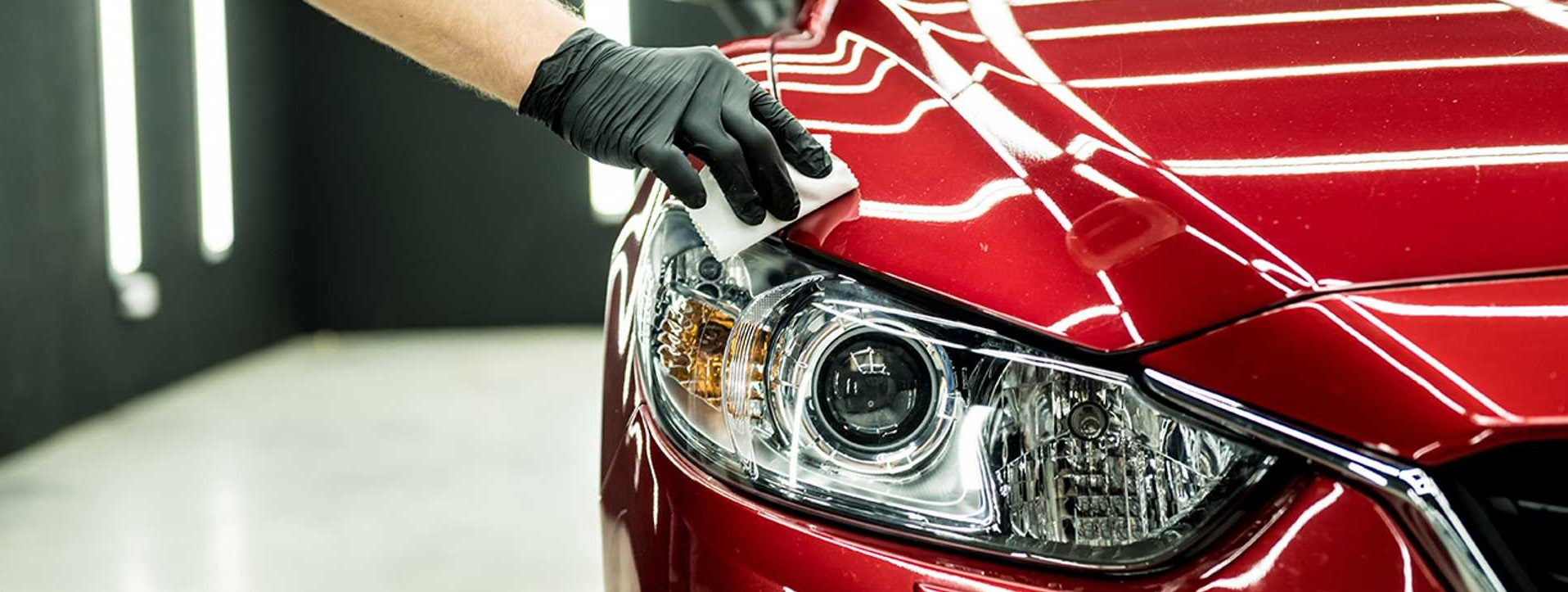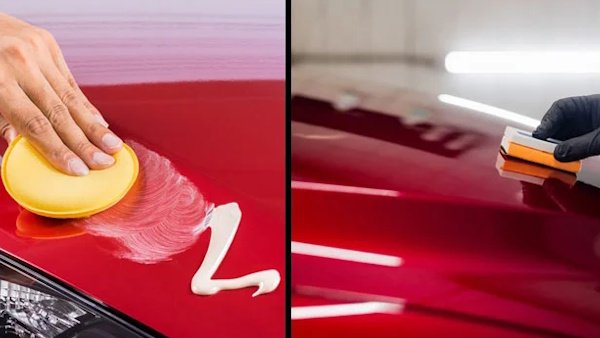How Ceramic Coating Newark can defend your vehicle from UV rays
Exploring the Scientific Research Behind Car Ceramic Coating and Its Protective Qualities
The science of car ceramic coating presents a fascinating study in advanced automotive protection. Composed mainly of silicon dioxide and polymers, these coverings create a robust bond with car paint. This interaction enhances longevity versus environmental threats while providing hydrophobic benefits. Nevertheless, the details of how these finishes job and their long-lasting benefits remain much less understood. Unboxing these details discloses why ceramic finishes are ending up being a preferred choice for vehicle care
What Is Ceramic Coating?
Ceramic coating is a fluid polymer that chemically bonds to the surface of a car's paint. This innovative protective layer enhances longevity and offers superior resistance to ecological aspects. Unlike typical wax or sealers, which give short-term security, ceramic finishings develop a resilient guard that can withstand severe problems such as UV rays, acidic contaminants, and extreme weather condition. When applied correctly, the coating creates a hydrophobic surface area, creating water to bead and slide off, which aids in maintaining the car's cleanliness. In addition, it offers boosted gloss and depth to the paint, making the automobile show up even more polished and vibrant. The application procedure commonly includes detailed surface area prep work, consisting of cleaning and sprucing up, to guarantee peak bonding. As an outcome, ceramic finishes are ending up being increasingly popular amongst car enthusiasts and those looking for to protect their investments, promising to maintain the automobile's aesthetic charm while lowering the frequency of maintenance.
The Structure of Ceramic Coatings
The complex formulation of ceramic coatings mostly consists of silicon dioxide (SiO2), which is stemmed from natural resources like quartz and sand. This vital component gives the foundation for the coating's resilience and safety qualities. In enhancement to SiO2, ceramic layers usually consist of numerous polymers and additives that enhance bond, flexibility, and resistance to environmental factors. These substances work synergistically to develop a robust barrier against impurities such as dirt, chemicals, and UV rays.Furthermore, some formulations include titanium dioxide (TiO2) or other nanomaterials, which can enhance the coating's hydrophobic residential or commercial properties, causing enhanced water repellency. The specific composition can vary significantly amongst suppliers, affecting efficiency and long life. Eventually, the mix of these elements culminates in a safety layer that not just improves the aesthetic appeal of lorries but additionally offers to extend their life-span by protecting the surface area from possible damage.
Just How Ceramic Coatings Job
Comprehending how ceramic finishings function involves exploring their chemical structure, which adds to their protective top qualities. The application procedure is necessary for attaining optimal outcomes, while durability and sturdiness factors figure out the coating's efficiency over time. With each other, these components highlight the benefits and efficiency of ceramic coverings for lorry defense.
Chemical Composition Explained
While lots of car proprietors seek resilient security for their lorries, the chemical structure of ceramic finishings plays a vital duty in their performance. These finishings mostly contain silicon dioxide (SiO2), which is acquired from natural minerals. This substance forms a strong bond with the car's paint, producing a resilient, safety layer. Additionally, many ceramic finishes have titanium dioxide (TiO2), improving their hydrophobic properties and resistance to UV rays. The existence of polysiloxanes can additionally boost flexibility and resilience. Together, these elements add to the coating's capacity to push back water, dust, and pollutants, while likewise providing a high-gloss finish. Understanding this chemical structure aids car owners value the robust protection supplied by ceramic coverings.
Application Process Introduction
Applying ceramic coverings includes a careful process that guarantees ideal bonding and security for the automobile's surface. Originally, extensive cleansing and decontamination of the car's outside are carried out to get rid of dust, gunk, and previous waxes. This action verifies that the surface area is devoid of contaminations that might prevent adhesion. Following this, the paint is commonly polished to boost clearness and get rid of any type of blemishes. Once prepared, the ceramic coating is used in small areas utilizing an applicator pad, enabling for consistent insurance coverage. The coating is then left to heal, forming a solid chemical bond with the surface. Appropriate curing times and problems are essential, as they verify the coating achieves its optimum effectiveness and protective high qualities.
Durability and Longevity Elements
Ceramic coatings are made to provide resilient defense with their sophisticated chemical structure, which produces a durable barrier against environmental pollutants. The resilience of these layers is affected by factors such as the thickness of the application, the quality of the product, and the conditions under which the vehicle is revealed. High-quality ceramic finishings can last numerous years, withstanding scratches, UV rays, and chemical stains. Appropriate upkeep, including routine washing and periodic reapplication, can further boost longevity. Additionally, environmental elements like environment and exposure to pollutants can influence the life expectancy of the coating. Generally, when applied and preserved properly, ceramic finishings use exceptional durability, making them a preferred choice for car lovers seeking to protect their vehicle's appearance.
Hydrophobic Properties and Water Repellency
Hydrophobic homes are a trademark of quality car ceramic layers, significantly improving the automobile's surface efficiency. These finishings create a molecular bond with the car's paint, resulting in a surface that drives away water efficiently. When water comes into contact with a ceramic-coated surface, it grains up and rolls off, lessening the amount of fluid that stays on the paint. This habits not only adds to an aesthetically pleasing appearance yet also lowers the build-up of pollutants such as dust, gunk, and roadway salts.The improved water repellency brings about less complicated cleaning and upkeep, as less effort is required to get rid of undesirable compounds. On top of that, the hydrophobic nature Recommended Reading of ceramic layers helps in preventing water spots, which can mar the surface of uncoated surfaces. Overall, the consolidation of hydrophobic homes in ceramic coatings plays a necessary role in keeping the vehicle's beautiful look while simplifying maintenance.
Defense Against Scratches and UV Damages
Car ceramic coatings provide significant defense versus scrapes and UV damages. The scratch resistance mechanism produces a long lasting layer that takes in impacts, while the UV securing see this here benefits aid preserve the vehicle's paint stability in time. Together, these functions add to a longer-lasting and aesthetically attractive coating.
Scrape Resistance Device
Utilizing advanced innovation, ceramic coatings provide a durable guard versus scrapes and UV damages, enhancing the long life and appearance of vehicle surface areas. The scratch resistance system of these layers is connected to their one-of-a-kind molecular framework, which creates a resilient bond with the lorry's paint. This bond develops a hard, safety layer that can absorb influences and withstand abrasions. In addition, the smooth surface of the coating lowers rubbing, making it challenging for impurities to adhere and cause scrapes. The chemical composition of ceramic coatings usually includes nanoparticles that strengthen the protective layer, more improving its strength. Consequently, lorries treated with ceramic finishings show considerably improved scratch resistance compared to traditional wax or sealers, making sure an immaculate surface in time.
UV Protecting Conveniences
The safety qualities of ceramic coverings prolong beyond scratch resistance to include significant UV securing advantages. These layers produce a durable obstacle that mirrors hazardous ultraviolet rays, securing the car's paint and underlying products. Extended direct exposure to UV radiation can bring about fading, oxidation, and wear and tear of the paint finish. By including ceramic coverings, automobile owners can effectively minimize these threats, preserving the aesthetic allure and honesty of their cars. Additionally, the UV blocking residential or commercial properties add to improved longevity, lowering the regularity of painting and upkeep. Inevitably, the assimilation of ceramic coatings uses a complete remedy for securing lorries from the damaging effects of sun exposure, guaranteeing a sustained, vibrant appearance with time.
The Long life and Upkeep of Ceramic Coatings

Regularly Asked Inquiries
Can Porcelain Coating Be Applied to Any Type Of Kind Of Lorry?
Ceramic coating can be put on numerous kinds of lorries, consisting of cars and trucks, trucks, and motorbikes. Surface area prep work and compatibility with details materials are vital for excellent attachment and efficiency of the coating.
Just How Much Does Ceramic Coating Normally Cost?
Ceramic coating generally sets you back between $500 and $2,000, depending on elements such as automobile size, coating high quality, and professional application. The investment can give resilient protection and boost the lorry's appearance gradually.

Is Specialist Application Necessary for Finest Outcomes?
The need of expert application frequently depends upon preferred outcomes. Specialists typically guarantee appropriate surface area preparation and application methods, resulting in ideal bonding and durability of the coating, which might be testing for inexperienced individuals to attain.
Can Porcelain Coatings Be Removed or Repaired?
Ceramic finishings can be eliminated or repaired, though the procedure may need certain solvents or strategies - Ceramic Coating Newark. Appropriate removal is vital to stay clear of damages to the underlying surface, stressing the importance of professional support for perfect outcomes
How Does Porcelain Coating Contrast to Traditional Wax?
The contrast between ceramic coating and typical wax discloses that ceramic coverings supply premium durability, enhanced defense versus environmental contaminants, and longer-lasting sparkle, while wax requires more regular application and supplies less overall resistance to damage.